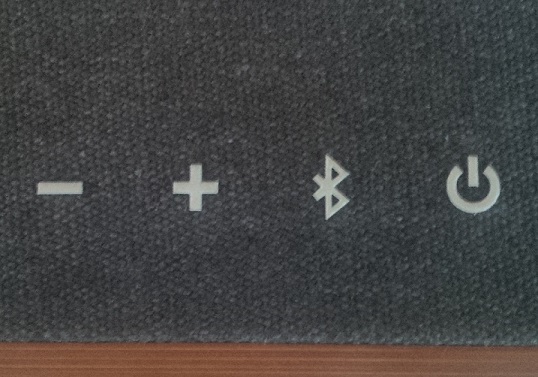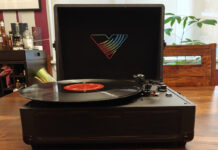 In 2010, relatives of Bob Marley created an electronics brand in partnership with HoMedics called the House of Marley. The brand aims to provide people with high-quality, eco-friendly sound technology and fashion. They also have a commitment to giving proceeds from their sales to their charity 1Love, a non-profit that hopes to bring change and peace to communities worldwide through various projects. I had the opportunity to try the latest addition to their speaker product line, the Get Together Bluetooth Portable Speaker, this week and here’s what I thought!
In 2010, relatives of Bob Marley created an electronics brand in partnership with HoMedics called the House of Marley. The brand aims to provide people with high-quality, eco-friendly sound technology and fashion. They also have a commitment to giving proceeds from their sales to their charity 1Love, a non-profit that hopes to bring change and peace to communities worldwide through various projects. I had the opportunity to try the latest addition to their speaker product line, the Get Together Bluetooth Portable Speaker, this week and here’s what I thought!
Get Together Bluetooth Portable Speaker Design and Setup
 I loved the design of this unit. The overall look is a throwback to the retro, old-school speakers of the 70’s. The front is covered in a light, sustainably-sourced bamboo with a stylish House of Marley symbol engraved in the middle. Inserted into the wood of the front paneling are four speakers: two 1” tweeters and two 3.5” woofers. The back is covered in a grey, House of Marley exclusive REWIND fabric cover (you also have the option of getting black or blue fabric covering instead). Along the top right there are four control buttons: volume up, volume down, Bluetooth and Power. Lastly, the inputs, for the charging cable etc., are discreetly placed along the bottom of the back of the unit.
I loved the design of this unit. The overall look is a throwback to the retro, old-school speakers of the 70’s. The front is covered in a light, sustainably-sourced bamboo with a stylish House of Marley symbol engraved in the middle. Inserted into the wood of the front paneling are four speakers: two 1” tweeters and two 3.5” woofers. The back is covered in a grey, House of Marley exclusive REWIND fabric cover (you also have the option of getting black or blue fabric covering instead). Along the top right there are four control buttons: volume up, volume down, Bluetooth and Power. Lastly, the inputs, for the charging cable etc., are discreetly placed along the bottom of the back of the unit.
 The box only contains the speaker and the charger cable, so setup basically just involved me plugging it in! Once plugged in, I liked that the speaker had a red light that illuminated while charging and turned off when complete. I don’t know how charged the battery was when I received this product, but it was fully charged after about 3 hours and the lithium ion battery contained in the unit claims to provide 8 hours of battery life.
The box only contains the speaker and the charger cable, so setup basically just involved me plugging it in! Once plugged in, I liked that the speaker had a red light that illuminated while charging and turned off when complete. I don’t know how charged the battery was when I received this product, but it was fully charged after about 3 hours and the lithium ion battery contained in the unit claims to provide 8 hours of battery life.
As this speaker is battery operated, it is marketed as a portable speaker which I think is perhaps a tad unrealistic due to its size and weight. It’s quite heavy, even compared to other speakers its size on the market, so I think it would be great on a patio or another area with few outlets but it’s not going to be something that you lug with you on a camping trip.
Connecting to this Marley speaker
In terms of connectivity, the Get Together speaker can be connected to audio devices via Bluetooth, AUX or USB cable. Though this provides you with some choice, it lacks some of the other connectivity options (such as NFC, Wi-Fi or AirPlay) that are available on many other speakers on the market right now.
 When connecting via Bluetooth, once I turned on the Bluetooth on my smartphone, I held down the Bluetooth button on the top of the speaker. As soon as it beeped, I was able to easily find the speaker on my smartphone and connect immediately. Once synced, I didn’t run into any issues with the sound cutting out until I was in the next room, or approximately 15 feet away from the speaker. The speaker did not come with an AUX cable, but I connected my phone with my personal AUX cable to test this mode of connectivity. Again, once connected, the phone played music through the speaker with no issues. This provides you with a relative universal connectivity option is your audio device doesn’t have Bluetooth. As someone who, until recently, had an archaic iPod, I always like when devices have an AUX option!
When connecting via Bluetooth, once I turned on the Bluetooth on my smartphone, I held down the Bluetooth button on the top of the speaker. As soon as it beeped, I was able to easily find the speaker on my smartphone and connect immediately. Once synced, I didn’t run into any issues with the sound cutting out until I was in the next room, or approximately 15 feet away from the speaker. The speaker did not come with an AUX cable, but I connected my phone with my personal AUX cable to test this mode of connectivity. Again, once connected, the phone played music through the speaker with no issues. This provides you with a relative universal connectivity option is your audio device doesn’t have Bluetooth. As someone who, until recently, had an archaic iPod, I always like when devices have an AUX option!
Sound Quality on the Marley Get Together
The sound quality and tone of this speaker was not what I was expecting. However, this is not necessarily a bad thing depending on what music you listen to. When I first saw this speaker I was assuming it was going to have a strong, bass-heavy sound as it had two larger woofers, but this didn’t end up being the case at all.
In reality, the tweeters are actually the most powerful component of the speaker. Powerful tweeters result in a great mids, which makes it great for listening to vocal-predominant tracks. When listening to a folky, singer-songwriter song like “This Is How We Walk on the Moon” by Jose Gonzalez, the vocals came out crisp and clear. Even at higher volumes, I found that the speaker balanced the voice component of the track well with the instrumental.
Where this speaker failed however, was with bass-heavy songs. As mentioned above, the tweeters are much more powerful than the woofers in this speaker, which therefore affects the speaker’s ability to handle bass. I was surprised by this choice by House of Marley because so much of the main stream market is dominated by bass-centric EDM and hip-hop tracks.
 To test out the bass, I tried two popular tracks by the Skrillex and Diplo side project, Jack Ü: “Febreeze” and “Take Ü There”. The sound felt very diluted when the beat was building up to drop and when it did drop, it was pretty underwhelming. The bass also became tinny and crackly at higher volumes. The crackly bass was further accentuated by the fact that the speaker’s volume spectrum sits on the louder end, even at the lowest setting, so it really didn’t take many pushes of the “volume up” button to completely lose the sound quality. Lastly, during other EDM songs, such as “Wildfire” by SBTRKT, the more intricate sections of beat mixing were lost as there were completely overpowered by the vocals.
To test out the bass, I tried two popular tracks by the Skrillex and Diplo side project, Jack Ü: “Febreeze” and “Take Ü There”. The sound felt very diluted when the beat was building up to drop and when it did drop, it was pretty underwhelming. The bass also became tinny and crackly at higher volumes. The crackly bass was further accentuated by the fact that the speaker’s volume spectrum sits on the louder end, even at the lowest setting, so it really didn’t take many pushes of the “volume up” button to completely lose the sound quality. Lastly, during other EDM songs, such as “Wildfire” by SBTRKT, the more intricate sections of beat mixing were lost as there were completely overpowered by the vocals.
All in all, I love the look of this speaker. The clean, retro look would complement the design scheme of many contemporary homes and the fact that it is battery operated makes it great for playing music outside as well. I also like House of Marley’s commitment to building products with sustainable materials and giving back to communities through their 1Love charity. Though this speaker’s sound quality faltered with tracks with heavier bass, the powerful tweeters in this speaker provided crisp, clear vocals, making it great for any rock or folk lover.
As it is a latest addition, this speaker is not yet available at Best Buy but if you like the idea of high-quality electronics manufactured with sustainable materials check out the rest of our House of Marley selection here!



